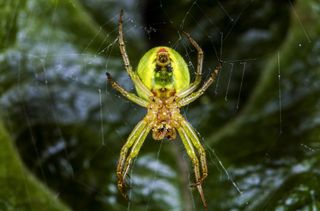ARACHNOPHOBIA TRIGGER WARNING
Newly discovered neon-green spider named after the 'Lady Gaga of mathematics'By Laura Geggel - Associate Editor
The spider is named after Cédric Villani, known as the 'Lady Gaga of mathematics,' who also loves spiders

The newfound Araniella villanii is an orb-weaver spider, a group that uses math to spin their webs.
(Image: © Anatoliy Ozernoy)
A newly discovered neon-green spider that uses math to build its incredibly precise and consistent webs has just been named after the "Lady Gaga of mathematics." The bright-green arachnid is part of the orb-weaver spider family (Araneidae), whose members "tend to build beautiful and architecturally aesthetic webs" that look like they adhere to the golden ratio, study lead researcher Alireza Zamani, a doctoral student in the Biodiversity Unit at the University of Turku in Finland, told Live Science.
In fact, a close relative — the garden orb-weaver spider (Araneus diadematus) — creates about 30 radial threads (the spoke-like lines extending from the web's middle) that form "an astonishingly constant angle of about 15 degrees, which the spider carefully measures using its front legs," Zamani said.
Related: Creepy, crawly & incredible: Photos of spiders
The newfound spider has similarly precise webs, he noted. To highlight the spider's fastidious weaving, Zamani named the newly discovered species Araniella villanii, after French mathematician Cédric Villani — the winner of the 2010 Fields Medal, a prize awarded to mathematicians under the age of 40. Villani is also apparently a huge spider fan.
"Villani’s love for spiders is evident by the constant presence of a spider brooch on his lapel," Zamani said. "Although he has never explained the reason behind his appreciation of these arachnids, we decided to make a connection between them in real life and name a mathematical spider after the spider-man mathematic!"
Image 1 of 3

The black "hairs" on the Araniella villanii spider are innervated, meaning they are sensory organs, much like a cat's whisker. (Image credit: Anatoliy Ozernoy)
2/3
The adult female Araniella villanii can grow to be 0.2 inches (6 millimeters) long. That's larger than the 0.1-inch-long (4.4 mm) males. (Image credit: Anatoliy Ozernoy)
3/3

The adult female Araniella villanii can grow to be 0.2 inches (6 millimeters) long. That's larger than the 0.1-inch-long (4.4 mm) males. (Image credit: Anatoliy Ozernoy)
3/3
A juvenile spider (Araniella villanii) that researchers just recently described. (Image credit: Anatoliy Ozernoy)
Granted, the similarities between Villani and the spider end there. Like other members of the Araniella genus, A. villanii eats small flying insects and builds its webs in woods, bushes and low vegetation, where the spiders' green bodies are camouflaged. (It's no wonder the nickname for Araniella is "green cucumber spiders," Zamani said.)
"Living specimens of Araniella spiders usually have a beautiful, striking green coloration, which is quite rare in spiders," Zamani said. "This is due to certain bile pigments called 'biliverdin,' which makes them very difficult to detect in nature."
A. villanii also has spiky black hairs covering its body. These hairs are innervated, meaning they can sense the outside world, much like a cat's whiskers.
This discovery shows just how many unknown species are likely still out there. A. villanii "is known from southwestern Iran, eastern Kazakhstan and northern India, a distribution range covering at least 10 countries, and yet, the species was unknown to science until now," Zamani said.
The study was published online Jan. 22 in the journal ZooKeys.
Incredible photos of peacock spider
Huntsman spider devours possum in viral (and terrifying) photos
In photos: Fish-eating spiders around the world
Originally published on Live Science.

No comments:
Post a Comment